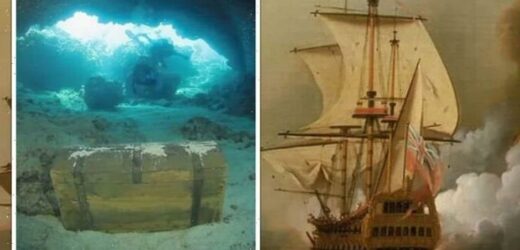Beyond Oak Island: A look at the San José galleon shipwreck
We use your sign-up to provide content in ways you’ve consented to and to improve our understanding of you. This may include adverts from us and 3rd parties based on our understanding. You can unsubscribe at any time. More info
The San Jose was a galleon of the Spanish Navy sunk by British warships in a battle off the coast of Cartagena, Colombia, in 1708. In November 2015, Jeff Kaeli, a research engineer with the Woods Hole Oceanographic Institution, confirmed he had found “the holy grail of shipwrecks” at the bottom of the Caribbean Sea. Bronze cannons engraved with dolphins – a telltale sign of its origin – were spotted thanks to the robot submarine Remus 6000 – which can dive nearly four miles and is equipped with sensors and cameras.
Now, the Colombian government has fired a legal broadside against rival claimants for an immense treasure.
It features a presidential decree calling for salvage companies to register to recover it.
The South American country has declared that it will submit a detailed inventory of everything found.
When San Jose sunk more than 300 years ago, it was carrying 180 tonnes of gold, solver and jewels estimated to be valued at more than $17billion (£12.6billion) today.


But Spain says the San Jose was a Spanish ship when it sunk and so, according to international conventions, Madrid owns everything on board.
Meanwhile, a Bolivian Indigenous group, the Qhara Qhara nation, is also claiming the treasure, saying the Spanish forced their ancestors to mine most of it in the 16th century.
In 2018, UNESCO urged Colombia to not “commercially exploit” the shipwreck.
It was on June 8, 1708, that the Spanish galleon burst into flames.
The ship and its sailors had been in battle with the British for hours as it was widely known it held great riches.

As it sank, 600 people were thrown under water, along with its treasure.
Jerry Lee, a treasure hunter at Global Explorations, said: “The San José was in Panama looting gold brought up from the West coast of South America, and it was there for a very long period of time so it stored a lot of gold along with several other ships.
“They all sailed for Cartagena, Colombia at the same time.”
In 2016, the Colombian government commissioned maritime archaeologists and the Woods Hole Oceanographic Institution – who located the Titanic in 1985 – to find the wreck.
DON’T MISS
Katya Adler warns of ‘huge concern’ as energy market could ‘collapse’ [INSIGHT]
Xi Jinping provides lifeline to Putin with 30-year gas deal [REPORT]
Russia’s terrifying arsenal of nuclear weapons exposed [REVEAL]


The first attempt was fruitless.On the second expedition at the end of 2015, however, the San José was finally uncovered.
John Mattera, a treasure hunter, previously said the Colombian government “probably has the strongest claim to the wreck” given that it is in the country’s waters.
The San Jose and its hold has, as a result, become one of the most sought after ships and treasures in history.
Divers are yet to recover the treasure due to the ongoing legal battle.
Source: Read Full Article


